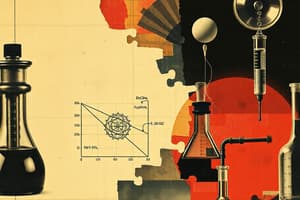Podcast
Questions and Answers
What does Boyle's Law state about the relationship between pressure and volume at constant temperature?
What does Boyle's Law state about the relationship between pressure and volume at constant temperature?
Pressure is inversely proportional to volume.
If the pressure on a gas increases from 1.0 atm to 1.4 atm, what happens to the volume of the gas?
If the pressure on a gas increases from 1.0 atm to 1.4 atm, what happens to the volume of the gas?
The volume decreases.
In the equation $P_1V_1 = P_2V_2$, what do the symbols $P_1$, $P_2$, $V_1$, and $V_2$ represent?
In the equation $P_1V_1 = P_2V_2$, what do the symbols $P_1$, $P_2$, $V_1$, and $V_2$ represent?
$P_1$ = Initial Pressure, $P_2$ = Final Pressure, $V_1$ = Initial Volume, $V_2$ = Final Volume
If a car has an internal volume of 12,000 L and the pressure changes from 1.0 atm to 1.4 atm, what will be the volume of the gas?
If a car has an internal volume of 12,000 L and the pressure changes from 1.0 atm to 1.4 atm, what will be the volume of the gas?
What will be the new pressure inside a 3 L container if the gas pressure decreased from 5 atm to a volume of 2 L?
What will be the new pressure inside a 3 L container if the gas pressure decreased from 5 atm to a volume of 2 L?
What is the new pressure of a gas if its volume decreases from 1.8 L to 750 mL (1.8 L = 1800 mL) and the initial pressure is 17.5 psi?
What is the new pressure of a gas if its volume decreases from 1.8 L to 750 mL (1.8 L = 1800 mL) and the initial pressure is 17.5 psi?
Flashcards are hidden until you start studying
Study Notes
Boyle's Law Overview
- Formulated by Robert Boyle in 1662; relationships between pressure (P) and volume (V) of gases.
- States that pressure and volume are inversely related when temperature is constant.
- The equation representing Boyle's Law: ( P_1V_1 = P_2V_2 ).
Key Concepts
- When volume increases, pressure decreases, and vice versa.
- Pressure and volume have a constant product at a given temperature.
- Robert Boyle lived from 1627 to 1691, contributing significantly to the field of chemistry and physics.
Equation Components
- ( P_1 ): Initial Pressure
- ( V_1 ): Initial Volume
- ( P_2 ): Final Pressure
- ( V_2 ): Final Volume
Applications of Boyle's Law
- Practical implications in pressure and volume calculations for gases under varying conditions.
- Critical for understanding gas behaviors in closed systems, such as engines and balloons.
Sample Problems
- Car with a volume of 12,000 L experiences pressure change from 1.0 atm to 1.4 atm; volume can be calculated using Boyle’s law.
- In a 3 L gas container at 5 atm where volume decreases to 2 L; new pressure can be determined by rearranging the law.
- A gas's initial volume of 1.8 L at 17.5 psi reduces to 750 mL; conversion to atm required for pressure calculation.
Studying That Suits You
Use AI to generate personalized quizzes and flashcards to suit your learning preferences.




